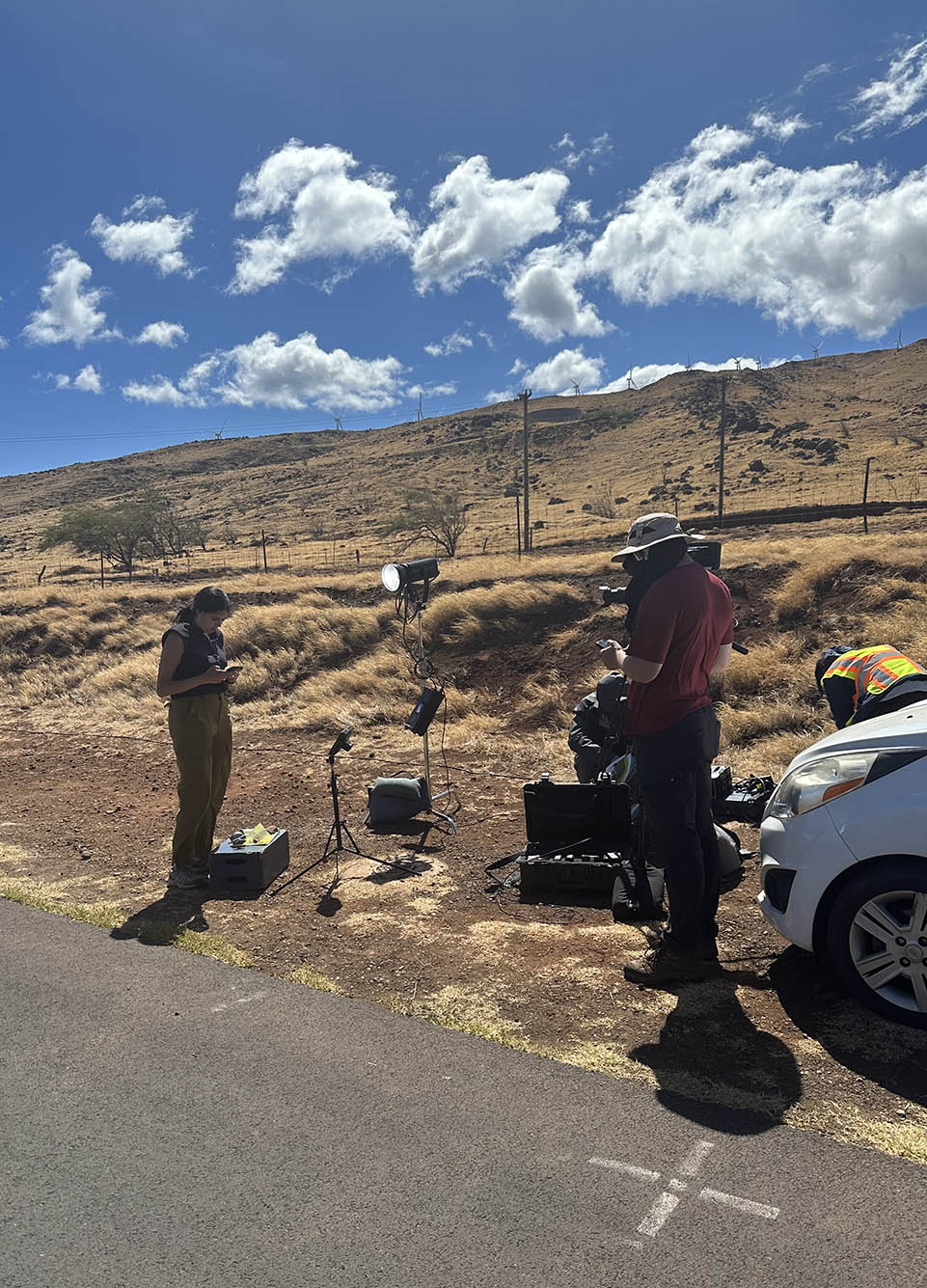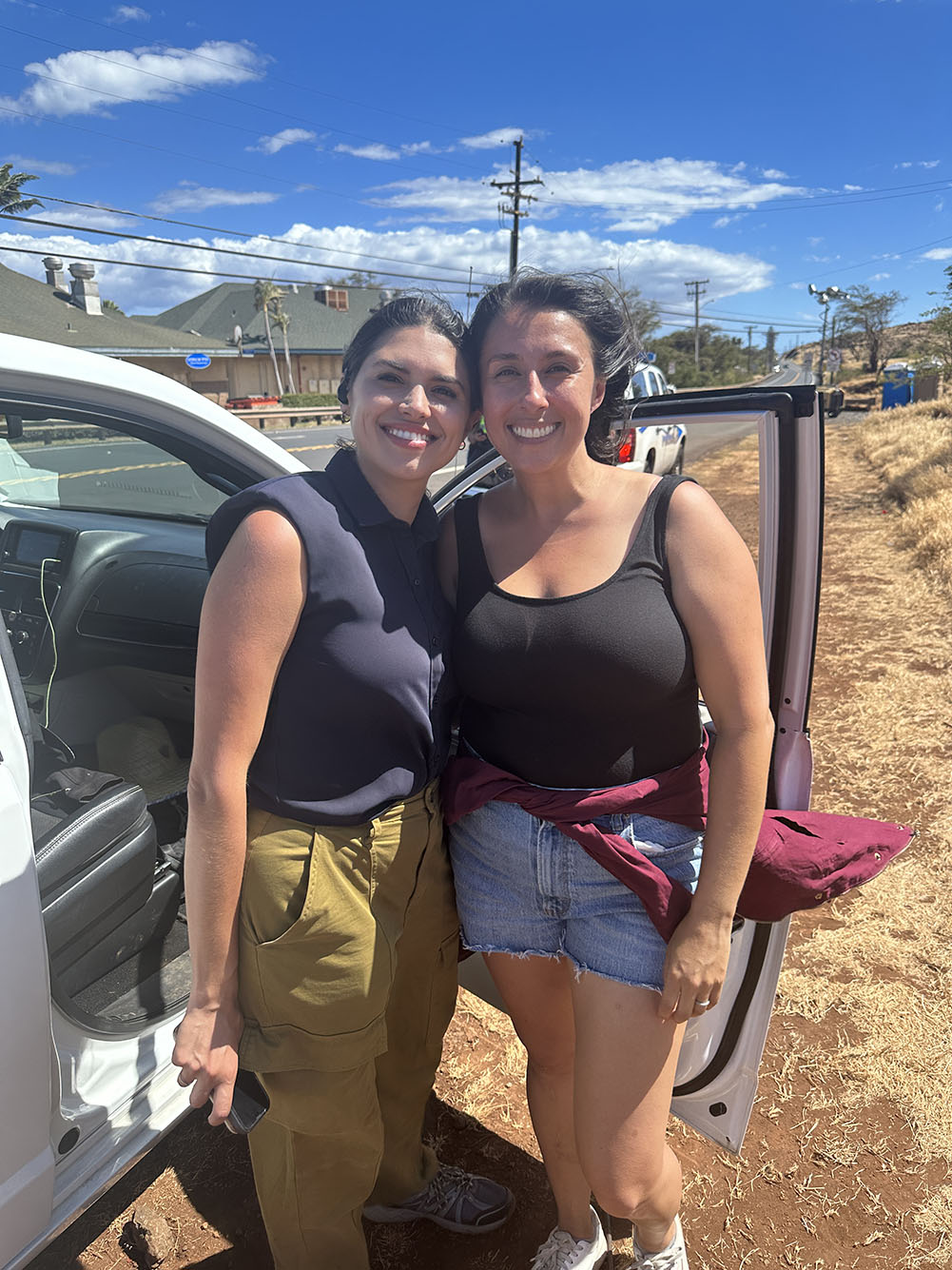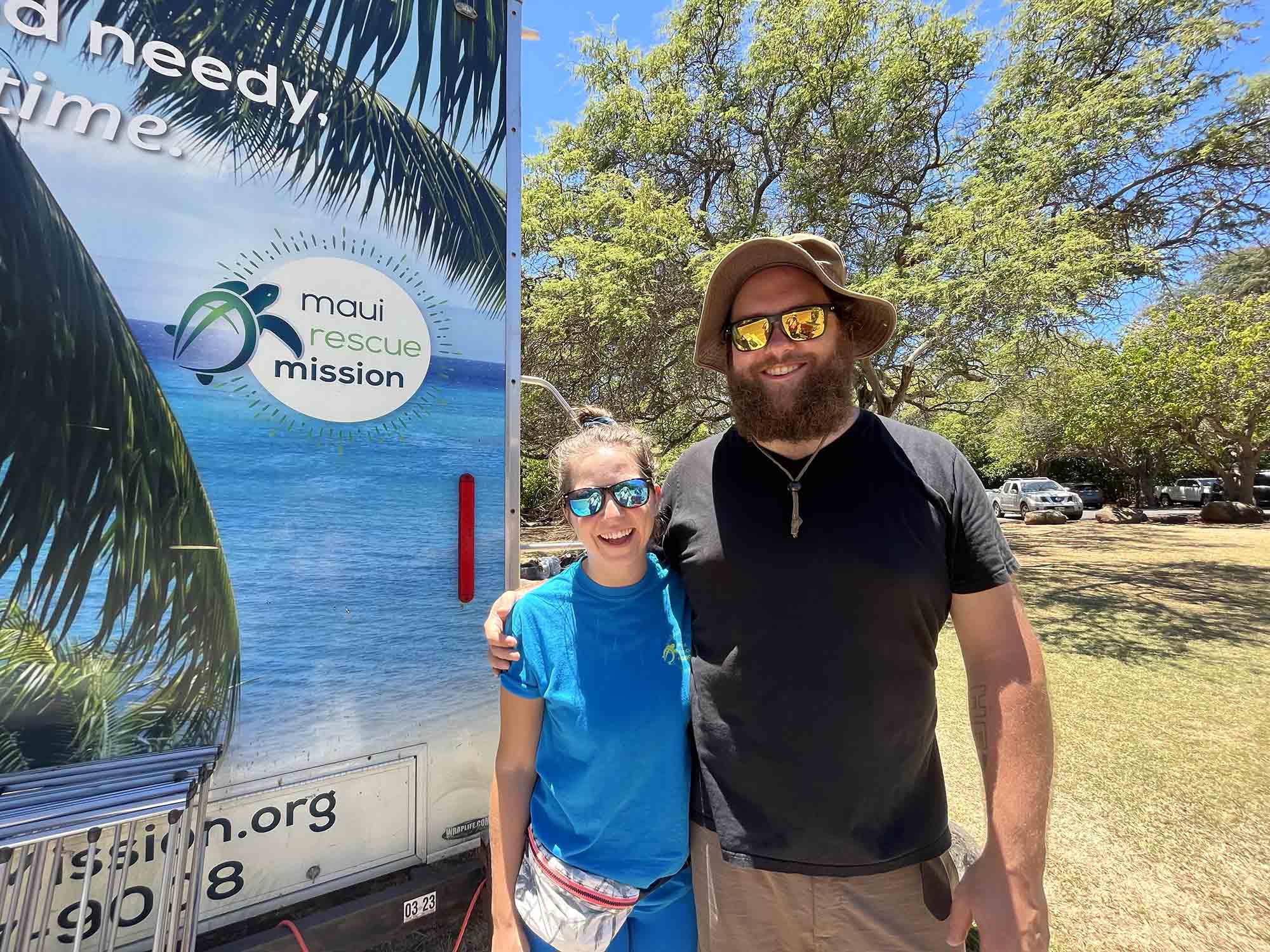Maui Wildfires Reunite Two BU Journalism Alums in the Field
Devastation also poses new challenges for a poli-sci alum working for the island’s homeless

Melissa Adan (COM’14) of ABC News reporting live from a roadside in Maui. Photo by Sandy Hooper (COM’13)
Maui Wildfires Reunite Two BU Journalism Alums in the Field
Devastation also poses new challenges for a poli-sci alum working for the island’s homeless
They talk seriously about the devastation and death this month’s wildfires have inflicted on the people of Maui. But journalists Melissa Adan of ABC News and Sandy Hooper of USA Today found one bright spot while reporting in the middle of the disaster—they got to see each other again for the first time in years.
The College of Communication alums met up on August 14, chatting for a few minutes on the roadside where Adan was doing live shots for ABC News Live, the network’s streaming channel.

“It’s sad. It’s hard to talk to people who have lost everything or who are living on the front lines and all their neighbors are gone,” says Hooper (COM’13), USA Today deputy managing editor of visuals, who has been shooting video in the hardest-hit areas of Lahaina. “It’s hard to hear those stories again and again. So, it’s nice to have someone like that—that I can just text and be like, ‘Yeah, it was a hard day today.’ It’s been nice to have a familiar face here.”
“I’ve interviewed maybe a dozen survivors,” Adan (COM’14) says. “I can sense it through their eyes, through their words, through the videos, through the photos that they send me of what they endured. One of my interviews today told me, ‘I went through hell and back.’ This is by far the worst natural disaster devastation story I have ever covered in my career.”
Adan says she and Hooper have been texting and helping each other, and she also says how much she appreciates having “a BU alum and friend that you can also lean on.”
It’s nice to have a BU alum and friend that you can also lean on.
The two worked together a decade ago as BU journalism students. Hooper, then a grad student, was the executive producer of Inside Boston on BUTV10 when undergrad Adan joined up.
“Melissa was incredible in college, and I had no doubt that she would be where she is now,” Hooper says. “She’s smart. She told really great stories. She understood all the elements that went into reporting. So it’s been really amazing to see her career.”
They kept in touch online, but it has been several years since they’ve seen each other in person. Adan became an ABC News correspondent after working for local affiliates. When she moved to Los Angeles earlier this year for the network, longtime resident Hooper talked to her on the phone about good neighborhoods to live in. But even while living in the same city for several months, they’ve been too busy to coordinate a get-together.
Then, both were sent to the Hawaiian island on short notice to report on the fires that wiped out the town of Lahaina and killed more than 100 people. Adan went first, on August 9, and Hooper two days later.
“When I knew I was coming, I sent her a text like, ‘Hey, how are you doing? I’m on my way to Hawaii, is there anything you need me to bring?’” Hooper says. “It’s a great thing to do when you’re out in the field, to connect with other journalists, I think it’s a good safety network.”
“There were no alarms, there were no warnings, Lahaina blew up like in a matter of five to 10 minutes,” a resident tells @melissaabcnews, as residents cope with devastation from wildfires. pic.twitter.com/ZTy7JSBTuR
— ABC News Live (@ABCNewsLive) August 14, 2023
“The Lahaina wildfire destroyed many of Paula Ventura’s neighbor’s homes, but Ventura’s house and her 20 cats survived the fire; she plans to stay.” Video courtesy of Sandy Hooper via USA Today
They texted each other tips on things like getting around in the fire zone amid official restrictions. And finally on Monday they actually met up.
“I pulled over to the side of the road where she was, and we just chatted before she had another live hit,” Hooper says. “She asked if I had been into Lahaina—I’d seen some very, very difficult things—and she’s like, it’s hard.
Adan says there will be stories for a long time about how the fires started—some reports blame power lines that snapped in high winds. “There’s criticism,” she says. “Why were the power lines not adjusted to be underground? Why were the power lines not at least turned off?”
Islanders also feel trepidation about the long-term rebuilding and real estate speculation, Adan says. “People in Maui cherish this land, and this land has now burned. And the fear is, how do we rebuild this land to continue honoring that and not have outsiders come in and try to take over what is historic and sacred to them?”
Helping the homeless—and now that’s everyone
Lauren Wittel-Henrie (CAS’14) met her husband, Ben Henrie, working with the homeless in New York. Two years ago they moved to Maui to help a friend and colleague grow the faith-based Maui Rescue Mission, which offers showers and laundry facilities from a mobile trailer to the homeless community on the island.
On weekly visits to church parking lots and other locations around the island, “we partner up with all different kinds of resources, like street medicine teams and legal aid so that people can take advantage of that while they’re waiting for their laundry,” says Wittel-Henrie, who is a public relations consultant to the mission and other nonprofit groups. “Or while they’re waiting to get a shower, they can have someone sit down and say, ‘How are you today? What’s actually going on? How can we help you in a more substantial way?’”

A lot changed with the fires. Although Wittel-Henrie’s home on the southern part of the island was untouched, many of the nonprofit’s regular clients are in difficult straits, and many more people needed their services, especially in devastated Lahaina. Their trailer is often set up at Lahaina Gateway, a shopping plaza just outside the zone of the worst destruction.
“We’re helping everyone right now, but the key for us is to find our unsheltered friends,” she says. “So often in disaster situations, the marginalized continue to remain marginalized. They’re not on any lists. They had problems with ID access before this happened. And so we’re out there looking for them, because we don’t know who else is looking for them.”
There are moments of hope among the devastation.
“We had one beautiful story,” Wittel-Henrie says. “This guy, his name is Happy Jack. He’s actually very angry, but we call him Happy Jack. When our team pulled up at the Gateway center, he was sitting there.” And they embraced him, and he was just crying and crying and saying that he’d thought he was dead.
“We gave him a shower and we sat with him and ate with him and he just stayed with us for most of the day. And then, miraculously, one of his relatives he’s been estranged from for years called the rescue mission to check on him.
“She came and she got him, which is incredible and beautiful. Miracles and beauty from the ashes.”
Comments & Discussion
Boston University moderates comments to facilitate an informed, substantive, civil conversation. Abusive, profane, self-promotional, misleading, incoherent or off-topic comments will be rejected. Moderators are staffed during regular business hours (EST) and can only accept comments written in English. Statistics or facts must include a citation or a link to the citation.